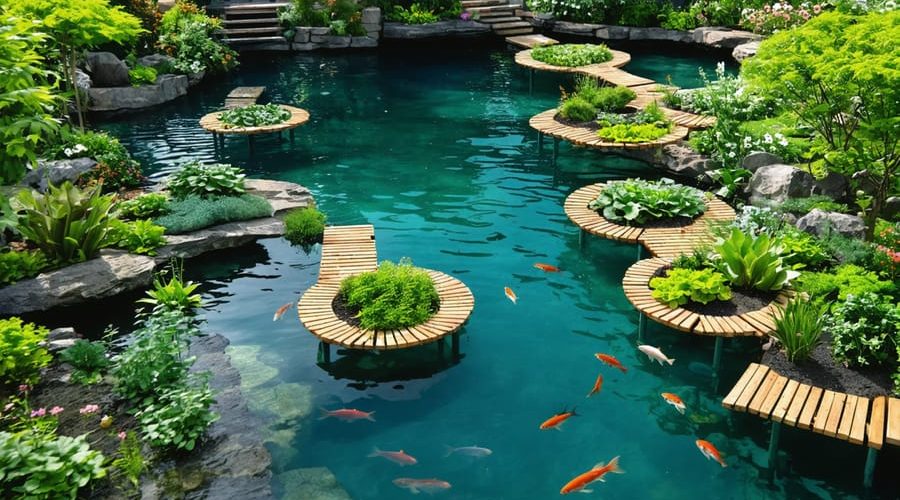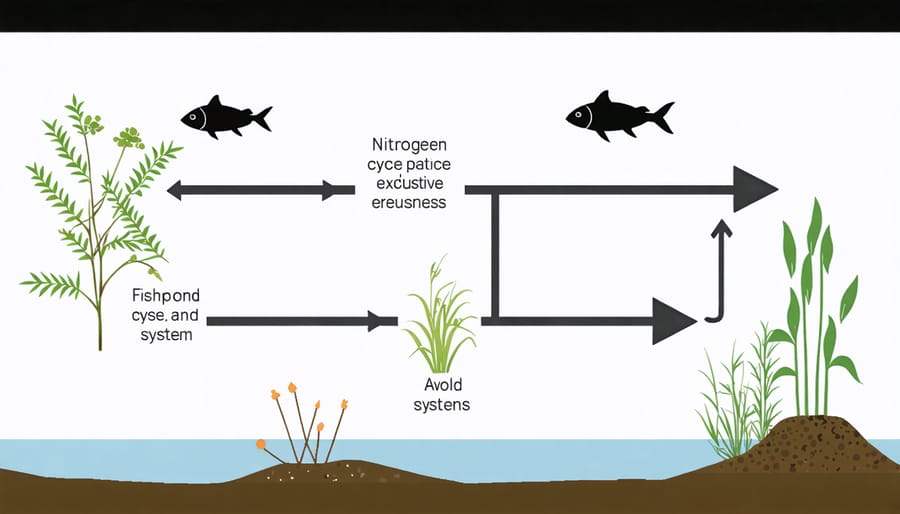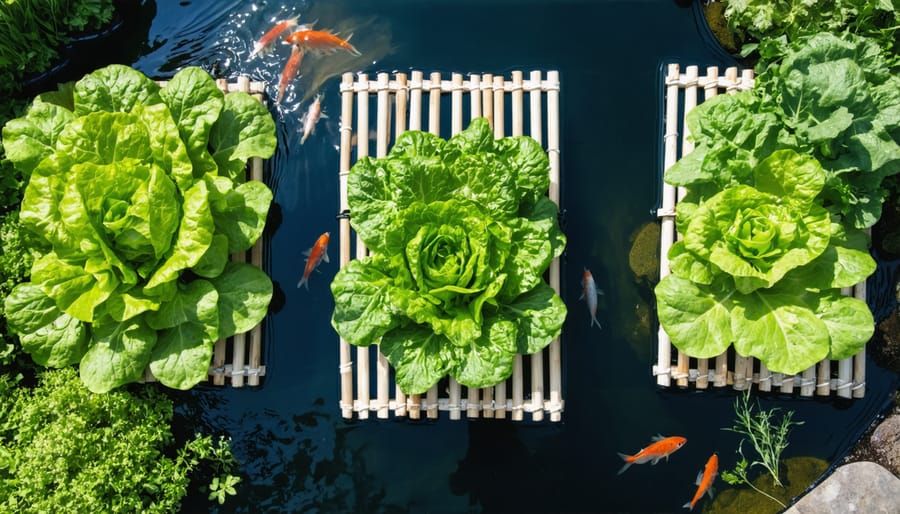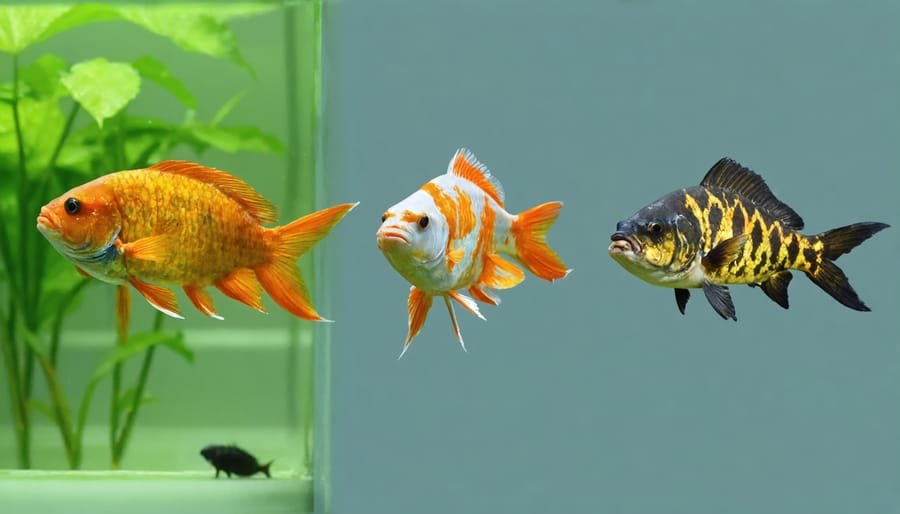
Fish Pond Hydroponics: Transform Your Backyard Into a Self-Sustaining Food System
Transform your backyard into a thriving ecosystem by combining fish farming with soilless plant cultivation. Fish pond hydroponics creates a perfect symbiotic relationship: fish waste fertilizes plants, while plants naturally filter water for the fish. This sustainable system, inspired by ancient farming techniques and modern educational garden ponds, produces both fresh vegetables and protein-rich fish year-round. Beyond its practical benefits, a well-designed fish pond hydroponics system adds visual appeal to any outdoor space while requiring minimal maintenance once established. Whether you’re a seasoned gardener or just starting your sustainability journey, this complete guide will walk you through creating your own productive water garden that harmoniously blends aquaculture with hydroponic growing methods.
How Fish Pond Hydroponics Works
The Nitrogen Cycle
The nitrogen cycle is the heart of pond hydroponics, turning fish waste into garden gold! When you understand these aquaponics basics, you’ll see how nature creates a perfect partnership between fish and plants. Here’s how it works: fish produce ammonia through their waste and gills, which would be harmful if it built up in the water. But beneficial bacteria come to the rescue! These microscopic helpers transform ammonia into nitrites and then into nitrates – exactly what your plants crave for healthy growth.
Think of it as a natural recycling system where nothing goes to waste. The plants act like a natural filter, absorbing these nitrates through their roots, which helps clean the water for your fish while feeding themselves. This cycle keeps going round and round, creating a balanced ecosystem that benefits both your fish and plants. The best part? Once established, this system requires minimal input from you, making it an eco-friendly way to grow fresh vegetables while maintaining a beautiful pond.

Water Flow Systems
In fish pond hydroponics, water circulation is the key to success, and there are several effective methods to move water between your fish and plants. The most popular approach is the pump-driven system, where a submersible pump moves nutrient-rich water from the fish pond to the growing beds. This water then naturally flows back to the pond through gravity.
Another method is the airlift system, which uses air bubbles to push water upward. This gentle approach is energy-efficient and helps aerate the water at the same time. For smaller setups, you might consider the flood and drain method, where growing beds are periodically filled and emptied using a bell siphon.
The continuous flow system keeps water moving steadily through plant beds before returning to the pond. This works especially well for leafy greens and herbs. For those interested in a low-tech solution, the raft system floats plants directly on the pond surface, though this works best in larger ponds with good filtration.
Remember to match your water flow system to your setup size and the types of plants you’re growing. A good rule of thumb is to circulate your entire pond volume at least once every hour.
Setting Up Your Fish Pond Hydroponic System
Pond Construction Basics
A well-constructed fish pond is the foundation of any successful hydroponic system. When planning your pond, start with proper ecosystem pond design principles to ensure a healthy environment for your fish. The ideal depth should be at least 3-4 feet to maintain stable water temperatures and give fish enough space to thrive.
Line your pond with high-quality EPDM rubber liner or use a pre-formed pond shell. Install a reliable filtration system that includes both mechanical and biological filtration to keep water clean and clear. A properly sized pump is essential – aim for circulating the entire pond volume once every hour.
Consider adding different zones within your pond. Include shallow shelves for placing hydroponic growing beds and deeper areas for fish to retreat. Proper aeration is crucial; install air stones or a waterfall feature to maintain optimal oxygen levels for both fish and plants.
Don’t forget about accessibility – create paths around the pond for easy maintenance and harvesting. Include bottom drains for cleaning and water changes, and position the pond where it receives adequate sunlight for plant growth but isn’t exposed to extreme temperature fluctuations.
Remember to slope the sides slightly to prevent liner damage from freezing in colder climates, and always include overflow provisions for heavy rain events.
Hydroponic Growing Areas
When setting up your fish pond hydroponics system, you have several exciting options for creating plant growing areas. The most popular choice is floating rafts, which are lightweight platforms that sit directly on the water’s surface. These rafts can be made from food-safe foam boards or specialized hydroponic floating materials, with holes cut out to hold net pots containing your plants.
Another effective option is creating grow beds around the pond’s perimeter. These can be either media-filled beds using materials like expanded clay pebbles or gravel, or nutrient film technique (NFT) channels that slope gently back toward the pond. The grow beds can be incorporated into the pond’s design as raised borders, creating an attractive and functional layout.
Vertical growing spaces are perfect for maximizing your growing area while adding visual interest. You can install tower systems or hanging gardens along the pond’s edge, which work especially well for leafy greens and compact herbs. Some gardeners even create cascading systems where water flows through multiple growing levels before returning to the pond.
For those with limited space, window box-style containers mounted on the pond’s edge offer a simple solution. These can be connected to the pond’s water circulation system and provide easy access for harvesting and maintenance. Remember to position your growing areas where they’ll receive adequate sunlight while maintaining easy access for regular maintenance.

Pump and Filtration Setup
Setting up your pump and filtration system is crucial for maintaining a healthy fish pond hydroponics system. You’ll need a submersible pump powerful enough to circulate water through your grow beds – typically, aim for a pump that can cycle your entire pond volume at least once per hour. For most backyard setups, a 1,000-2,000 GPH pump works well.
Essential equipment includes:
– Submersible pond pump
– Mechanical filter (to catch solid waste)
– Biological filter media
– UV clarifier (optional but recommended)
– PVC pipes and fittings
– Check valves
– Flow control valves
Start by placing the pump at the deepest part of your pond. Connect it to a mechanical filter first – this catches solid waste before it reaches your grow beds. Next, install the biological filter, which houses beneficial bacteria that convert fish waste into plant nutrients.
Run your main water line to a manifold that splits the flow between different grow beds. Install flow control valves on each line so you can adjust water distribution. Remember to place check valves to prevent backflow when the pump is off.
For best results, position your grow beds slightly higher than the pond surface. This allows water to drain back into the pond naturally through gravity. Make sure all connections are secure and waterproof to prevent leaks.
Test your system thoroughly before adding fish or plants, running it for at least 24 hours to check for any issues.
Choosing Fish and Plants
Best Fish Species
When choosing fish for your pond hydroponics system, certain species stand out for their hardiness and compatibility with plant cultivation. Tilapia is often considered the gold standard, thanks to their rapid growth, disease resistance, and ability to thrive in varying water conditions. They’re also excellent at converting feed into protein, making them highly efficient.
Channel catfish are another excellent choice, particularly in temperate climates. They’re hardy, adaptable, and can handle temperature fluctuations well. Plus, they’re bottom feeders who help keep your pond clean by consuming debris that settles at the base.
For cooler climates, consider rainbow trout. They prefer temperatures between 50-60°F and provide nutrient-rich water for your plants. However, they do require more oxygen than other species, so ensure your system has good aeration.
Koi and goldfish, while primarily ornamental, can work well in hobby-scale systems. They’re hardy, disease-resistant, and produce plenty of nutrients for plants. Keep in mind they grow slower than food fish but add beautiful colors to your pond.
Common carp are also worth considering for larger systems. They’re incredibly resilient, can tolerate poor water quality, and produce abundant nutrients for plants. However, they can grow quite large, so ensure your pond has adequate space.
Remember to choose fish species that match your climate, system size, and maintenance capabilities. Start with fewer fish than you think you need – you can always add more as your system stabilizes.

Suitable Plants
When choosing plants for your fish pond hydroponic system, you’ll want to select species that not only thrive in water but also contribute to the ecosystem’s balance. Some powerhouse plants for ponds include water lettuce, water spinach, and watercress, which are excellent at absorbing excess nutrients while providing edible harvests.
Leafy greens are particularly successful in these systems, with butter lettuce, Swiss chard, and kale showing impressive growth rates. These plants have shallow root systems that easily adapt to floating rafts or grow beds. Herbs like mint, basil, and parsley also flourish, adding both practical value and pleasant aromas to your setup.
For flowering options, consider peace lilies and umbrella palms, which help purify the water while adding visual interest. These ornamental choices work well alongside edible plants, creating a beautiful and functional system. Remember to start with just a few varieties and gradually expand as you gain experience.
Most importantly, avoid plants that might be invasive in your area or those that require soil-based nutrients to thrive. Stick to species that naturally grow in or near water bodies, as these will adapt best to your hydroponic system and support your fish’s health through natural filtration.
Maintenance and Troubleshooting
Daily and Weekly Tasks
To keep your fish pond hydroponics system thriving, establish a consistent maintenance routine. Daily tasks include checking water temperature, observing fish behavior, and ensuring all pumps and filters are running smoothly. Feed your fish once or twice daily, removing any uneaten food after 15 minutes to prevent water contamination.
Weekly maintenance involves testing water quality parameters including pH, ammonia, nitrites, and nitrates. Clean mechanical filters and remove any debris from the pond surface. Inspect plant roots for signs of disease or pest infestation, and prune dead or yellowing leaves. Top up water levels as needed, accounting for evaporation.
Check grow beds for proper water flow and clean any clogged pipes or drippers. Harvest mature plants and replace them with new seedlings to maintain continuous production. Monitor fish for any signs of illness or stress, and adjust feeding amounts based on their appetite and activity levels.
Record all maintenance activities and water test results in a logbook to track system performance and identify potential issues early. This helps establish patterns and makes troubleshooting easier if problems arise.
Common Issues and Solutions
Even well-maintained fish pond hydroponics systems can face challenges, but most issues have straightforward solutions. One common problem is algae overgrowth, which can be managed by adding more shade plants or installing UV filters. If you notice yellowing leaves on your plants, it’s usually a sign of nutrient deficiency – simply adjust your fish feeding schedule or add organic supplements.
Water temperature fluctuations can stress both fish and plants. Installing a pond aerator and maintaining proper depth (at least 2-3 feet) helps stabilize temperatures. Cloudy water often indicates excess nutrients or insufficient filtration – regular water testing and filter maintenance will keep things crystal clear.
Some plants might struggle with root rot in constantly wet conditions. Combat this by ensuring proper spacing between plants and maintaining good water circulation. Fish health issues typically stem from overcrowding or poor water quality. Keep fish numbers appropriate for your pond size and perform regular water changes.
Pest problems can be managed naturally using companion planting or introducing beneficial insects. Remember, a balanced ecosystem is your best defense against most common issues.
Fish pond hydroponics offers an incredible opportunity to create a sustainable, productive, and beautiful outdoor space that benefits both you and the environment. By combining traditional fish keeping with hydroponic growing, you’re not just creating a gorgeous water feature – you’re establishing a complete ecosystem that provides fresh vegetables, herbs, and fish for your table.
The benefits of this integrated system are truly remarkable. You’ll save water compared to traditional gardening, reduce the need for chemical fertilizers, and create a self-sustaining cycle where fish and plants support each other’s growth. The system also requires minimal maintenance once established, making it perfect for busy homeowners who want to grow their own food.
Starting your own fish pond hydroponics system doesn’t have to be overwhelming. Begin with a simple setup and expand as you gain confidence. Whether you have a small backyard or acres of land, there’s a system scale that will work for you. The satisfaction of harvesting your first crop of lettuce or catching your first fish will make all the initial effort worthwhile.
Ready to get started? Take that first step today. Plan your system, gather your materials, and join the growing community of fish pond hydroponics enthusiasts. Your future self will thank you for creating this sustainable source of fresh food and natural beauty right in your own backyard.
